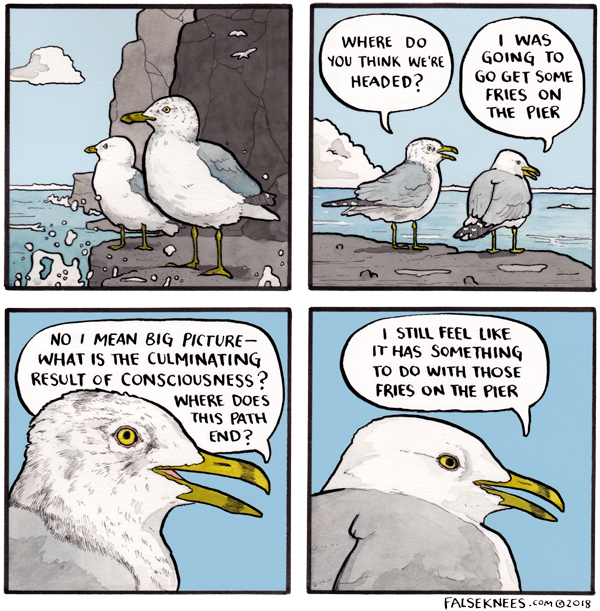I mean some people are benefiting from it
- 0 Posts
- 22 Comments

 221·2 months ago
221·2 months agoJust fork it 🤓
It definitely feels like a knee jerk reaction, but there would be some merit to it: The Rust language feels apt to implement a kernel with. If I remember correctly that’s what Redox is trying to accomplish? https://redox-os.org/
Why would using it on PC degrade image quality, if anything a desktop with a good GPU would potentially beat a PS5 in terms of graphics?
An adapter will be required to plug the PSVR2 though, that information is already available. But once plugged it should work with SteamVR.
I’m fine with bank heists but please don’t loiter :(
edit: English not my first language yada yada, I confused “loitering” for “littering”… I’m fine with loitering after all

 1·7 months ago
1·7 months agoThe message transferred between the particles supposedly FTL does contain information though. What I meant was that we cannot encode our own arbitrary information on top of it. The message has a physical effect on reality, without it the state we find the particles in cannot be respected.
Just reconsider this: If we agree that the result of a measurement is totally random (no hidden variable predetermining the result of the measurement) but that once we measure and know the state of one particle then we know with certainty the state of the other particle (entanglement): information about the collapse of the first measured particle was shared to the other so that it’s no longer random.
edit: If your argument is about “sharing information doesn’t imply transmission” then let’s stop here and leave this thread agreeing that “information was shared” :)
I have no opinions on what shape the information sharing takes. Nor am I interested in guessing.

 2·7 months ago
2·7 months agoI mean you can setup a source of entangled particles and two very far detectors that would do measurements roughly at the same time on each particle in such a way that information traveling at the speed of light wouldn’t have time to travel the distance between both detectors.
You can then just gather roughly simultaneous measurements and at a later time join the datasets from both detectors to see what one measured vs the other for each pair.
If I understand correctly the current observations show that collapsing the state of one of the particle influences the other all the way at the other detector. Since there’s no hidden variables that predetermine the result of measurements while the result of the collapse is random, and the fact that particles still respect the correlation over any distance is why there seem to be a FTL communication between the particles.
Something has to be communicated between the particles for the influence to work FTL, but it also seem we cannot leverage this phenomenon to send “actual information” this way :/
edit: Important point with that experiment: once the particles have been observed, if you try the experiment a second time using the same particles, then you’ll get different results, this time in line with hidden variables because the particle’s state already collapsed.

 2·7 months ago
2·7 months agoIf you can avoid running batch files altogether then great, amazing. But there are projects out there using Rust that still depend on running those and that’s the focus of the issue… But yeah I cannot wait until the day I won’t hear about cmd.exe again.

 3·7 months ago
3·7 months agoThe 2022 nobel prize was given to experimentalists that observed the violation of Bell’s inequality.
https://en.m.wikipedia.org/wiki/Bell's_theorem https://en.m.wikipedia.org/wiki/Quantum_nonlocality
I’m genuinely not an expert but I get it to mean that there aren’t hidden variables created alongside the entangled particles.

 1·7 months ago
1·7 months agoTo run a batch file, you must start the command interpreter; set lpApplicationName to cmd.exe and set lpCommandLine to the following arguments: /c plus the name of the batch file.
Because a batch file (.bat or .cmd) is basically a set of cmd.exe instructions I guess that’s why you can’t get away from it.
And as if making sense of this
CreateProcessAsystem call wasn’t funny enough, you also need to figure out how to safely prepare thatlpCommandLinefor it following all of cmd.exe’s weird escaping rules… lol

 9·7 months ago
9·7 months agoIt’s definitely not Rust’s fault, but it’s kinda Windows’ one and cmd.exe escape logic… It’s really difficult to write logic that will correctly escape any argument given to it, cmd.exe really is a pain to deal with :/
The Rust security team faced a significant challenge when dealing with cmd.exe’s complexity since they couldn’t find a solution that would correctly escape arguments in all cases.
As a result, they had to improve the robustness of the escaping code and modify the Command API. If the Command API cannot safely escape an argument while spawning the process, it returns an InvalidInput error.
“If you implement the escaping yourself or only handle trusted inputs, on Windows you can also use the CommandExt::raw_arg method to bypass the standard library’s escaping logic,” the Rust Security Response WG added.
I get that in situations where they can’t safely escape a parameter they’ll just stop with an error, which sound as sane as one could go with this!

 1·7 months ago
1·7 months agoIt’s like piercings that healed except the hole is in the hands? I want to believe he did something so that they didn’t have to mutilate his hands every 35 times they did this… But at the same time the face he makes when they remove the nails is not reassuring me :/
It’s like you’re sucking the fun out of us… Wait a minute

 12·10 months ago
12·10 months agoPlease change “added a sponsored detour” to “proposed a sponsored detour” and it won’t be as misleading anymore
As long as people spend money on it the cycle will continue. Publishers seem to have found the quality threshold people are still willing to pay for. It makes me mad but I can’t control what other people do with their money…






Because believe it or not Twitter is still popular despite everything